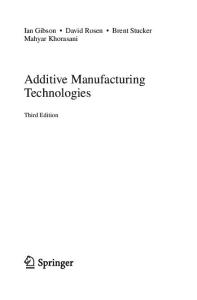Additive Manufacturing in Modern Combustion Engines
- PDF / 849,328 Bytes
- 6 Pages / 595.276 x 790.866 pts Page_size
- 82 Downloads / 404 Views
Additive Manufacturing in Modern Combustion Engines © FEV
In the research project LeiMot, FEV Europe together with partners is pursuing new approaches in the development of large engine components for additive manufacturing and higher plastic material application for weight reduction and functional improvement.
THE LEIMOT PROJECT
Modern passenger car gasoline and Diesel engines in all-aluminum design have been cost and weight optimized using the latest conventional production techniques. The weight-to-power ratio of these engines has taken an asymptotic path in recent years. It converges toward 1.1 kg/kW for threeand four-cylinder engines [1]. This behavior represents the balance be tween material properties, load profile and usage of the structure under given production boundary conditions of the engine. It shows that a further significant weight reduction with conventional production techniques is not to be expected. Changing the production process to the Laser Powder Bed Fusion (LPBF) method allows a step to further
38
weight reduction with same or similar materials and load profiles. In the LeiMot (Leichtbau Motor) project, which is sponsored by the German Federal Ministry of Economics and Technology (BMWi) under the leadership of FEV Europe, a cylinder head and a crankcase have been developed for the LPBF process. A diesel aggregate has been selected for its higher mechanical load capacity (Volkswagen 2.0-l TDI, EA288 evo). The components have been developed according to the substitution concept. For the additive manufactured components, AlSi10Mg powder has been adopted, which is the most commonly used aluminum alloy in Additive Manufacturing (AM). The higher degree of freedom of the AM design was used not only to reduce weight but also to improve the function of the engine.
During the development of the LeiMot engine concept, AM boundary conditions for the design of the cylinder head and the crankcase have been consistently followed from concept to the manufacturing process inclu ding support structures, orientation and aftertreatment [2]. In addition, the use of the thermoset injection molding process was defined as a goal. In order to use it sensibly, it was necessary to develop a suitable crankcase concept. The material available is a fiber composite plastic (FRP) based on glass fiber reinforced phenolic resin. CONCEPTION OF THE PARTS
Initially, the cylinder head and crankcase were dissected to their functions.
A U T H O RS
Dipl.-Ing. Bernd Lindemann is Vice President Diesel Powertrains of FEV Europe GmbH in Aachen (Germany).
Stefano Ghetti, M. Sc. Eng. is Director Diesel Powertrains of FEV Europe GmbH in Aachen (Germany).
Dipl.-Ing. Ralf Bey is Senior Projekt Manager Diesel Powertrains and Head of LeiMot Project of FEV Europe GmbH in Aachen (Germany).
In this way, each function can be analyzed from the very basis and their layout can be tailored to suit the given requirements. One major concept requirement was a crosscompatibility between the LeiMot cylinder head and Volkswagen’s base c
Data Loading...











